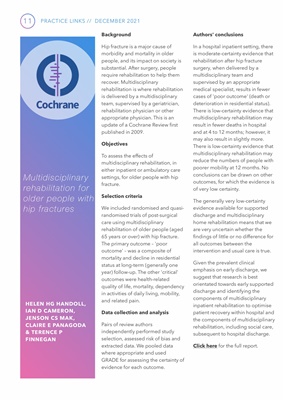
11 PRACTICE LINKS // DECEMBER 2021
HELEN HG HANDOLL,
IAN D CAMERON,
JENSON CS MAK,
CLAIRE E PANAGODA
& TERENCE P
FINNEGAN
Multidisciplinary
rehabilitation for
older people with
hip fractures
Background
Hip fracture is a major cause of
morbidity and mortality in older
people, and its impact on society is
substantial. After surgery, people
require rehabilitation to help them
recover. Multidisciplinary
rehabilitation is where rehabilitation
is delivered by a multidisciplinary
team, supervised by a geriatrician,
rehabilitation physician or other
appropriate physician. This is an
update of a Cochrane Review first
published in 2009.
Objectives
To assess the effects of
multidisciplinary rehabilitation, in
either inpatient or ambulatory care
settings, for older people with hip
fracture.
Selection criteria
We included randomised and quasirandomised
trials of post-surgical
care using multidisciplinary
rehabilitation of older people (aged
65 years or over) with hip fracture.
The primary outcome - 'poor
outcome' - was a composite of
mortality and decline in residential
status at long-term (generally one
year) follow-up. The other 'critical'
outcomes were health-related
quality of life, mortality, dependency
in activities of daily living, mobility,
and related pain.
Data collection and analysis
Pairs of review authors
independently performed study
selection, assessed risk of bias and
extracted data. We pooled data
where appropriate and used
GRADE for assessing the certainty of
evidence for each outcome.
Authors' conclusions
In a hospital inpatient setting, there
is moderate-certainty evidence that
rehabilitation after hip fracture
surgery, when delivered by a
multidisciplinary team and
supervised by an appropriate
medical specialist, results in fewer
cases of 'poor outcome' (death or
deterioration in residential status).
There is low-certainty evidence that
multidisciplinary rehabilitation may
result in fewer deaths in hospital
and at 4 to 12 months; however, it
may also result in slightly more.
There is low-certainty evidence that
multidisciplinary rehabilitation may
reduce the numbers of people with
poorer mobility at 12 months. No
conclusions can be drawn on other
outcomes, for which the evidence is
of very low certainty.
The generally very low-certainty
evidence available for supported
discharge and multidisciplinary
home rehabilitation means that we
are very uncertain whether the
findings of little or no difference for
all outcomes between the
intervention and usual care is true.
Given the prevalent clinical
emphasis on early discharge, we
suggest that research is best
orientated towards early supported
discharge and identifying the
components of multidisciplinary
inpatient rehabilitation to optimise
patient recovery within hospital and
the components of multidisciplinary
rehabilitation, including social care,
subsequent to hospital discharge.
Click here for the full report.